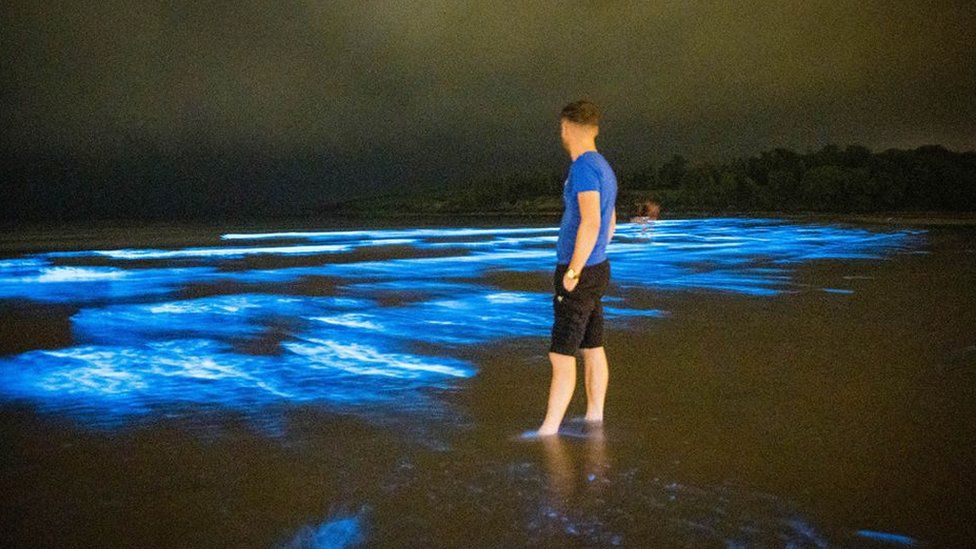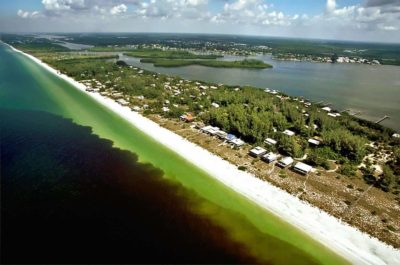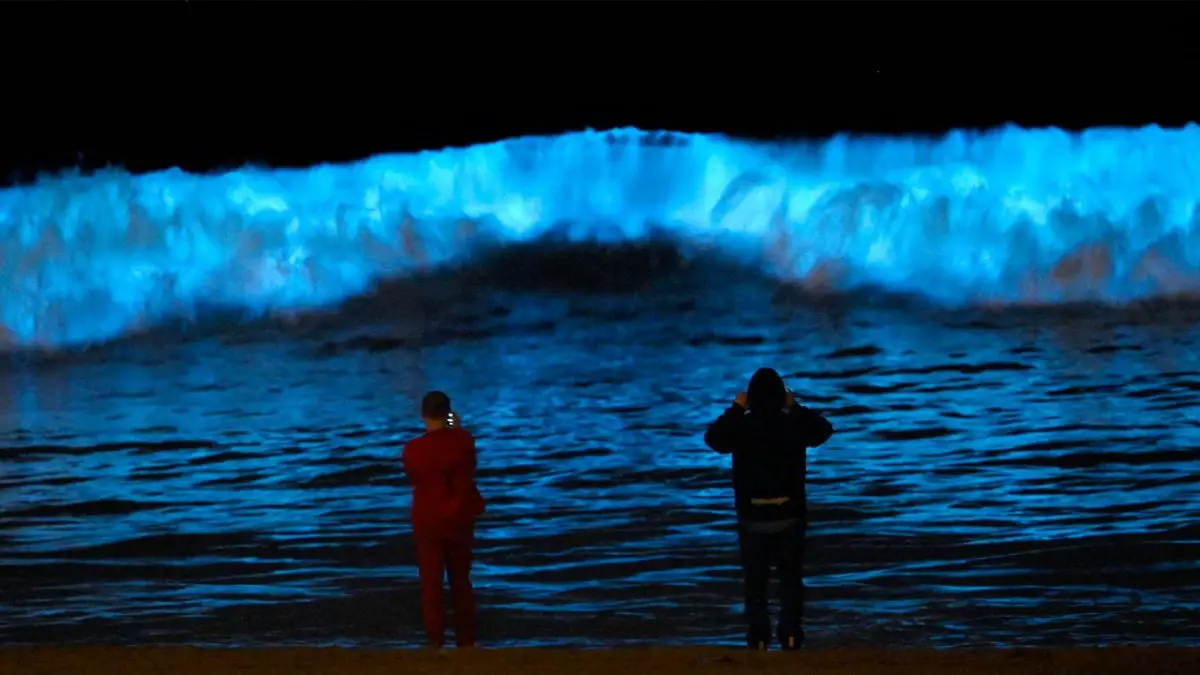The ocean carries many mysteries like the phenomenon known as Red Tide which closes beaches down in the Gulf States and causes health hazards when the ocean water turns red, due to a bloom of algae from an overabundance of nutrients has been linked to a similar phenomenon of Bioluminescence. What is a Bioluminescent Ocean?
Bioluminescence Ocean is a phenomenon occurring when one-cell organisms called dinoflagellates are disturbed by ocean waves & movement produces a chemical reaction using compounds combined with oxygen to emit light used as a defense mechanism against predators & adding a blue-green glow to ocean H2O.
Bioluminescent organisms live throughout the water column, from the very top of the ocean’s surface to the deepest darkest depths of the sea, from near the coast to the vast open ocean.
Bioluminescence Water
The meaning of Bioluminescence is light being emitted by living things through chemical reactions in their bodies. Bioluminescence is considered a cold light. Cold light means less than 20% of the light generates thermal radiation or heat.
There are bioluminescent organisms, like fireflies, and fungi found on land but most are found in marine vertebrates and invertebrates of seawater creatures like unicellular dinoflagellates, algae, and fungi, as well as animals ranging from jellyfish, annelids, and mollusks to shrimp, fireflies, echinoderms, and even some fish living in the ocean.
Bioluminescent organisms make their home in the deep saltwater of the vast ocean. These organisms generate a blue-colored light which is the same color as the ocean.
For this chemical reaction to happen to result in bioluminescence requires two unique chemicals called luciferin and either luciferase or photoprotein. Some bioluminescent organisms can be an essential food source for marine ecosystems while others can produce deadly neurotoxins that can harm fish and people alike.
What Causes Bioluminescence
Bioluminescence in ocean water occurs due to tiny, floating single-cell organisms called dinoflagellates that are classified as Protist. When this bioluminescence organism is disturbed or provoked a chemical reaction takes place inside them that emits blue-green light.
Blue-green colors are shorter wavelengths of light, which can travel through and thus be seen in both shallow and deep water. Bioluminescent blooms that are normally algae can cover hundreds of square miles of water, making for a breathtaking scene. Most dinoflagellates are microscopic but some can grow as big as 2 millimeters in diameter.
Bioluminescence does not always come from or depend on light absorbed by the organism. It derives from a highly energy-yielding chemical reaction in which excess energy is transformed into light energy instead of being all lost as heat.
When these dinoflagellates sense a movement in the water which could be waves in the ocean or another organism that may want to eat them, the dinoflagellates will let out a flash of light that they use as a defense mechanism to startle any predators allowing them to get away.
For the Phenomenon of Bioluminescence to occur, it requires two special chemicals combined with oxygen called
- Luciferin
- Luciferase or photoprotein.
Luciferin is the chemical compound that actually produces light. In the chemical reaction, luciferin is called the substrate. These molecules, when mixed react in the presence of oxygen and produce light. Blue light is
Many bioluminescence marine species along with dinoflagellates emit blue light because blue light can travel the farthest in water. Since water absorbs other colors of the spectrum faster.
Some tiny organisms can carry these proteins necessary to make Bioluminescence like dinoflagellate which is a one-celled marine organism that is a major component of plankton and can create a bluish-green color that is very beautiful but some species can be deadly. These toxic marine organisms can end up in seafood to make people that eat the seafood sick.
Some bioluminescent organisms do not synthesize luciferin. Instead, they absorb it through other organisms, either as food or in a symbiotic relationship. These dinoflagellates also need delicate specific conditions to thrive, like enough warmth salinity, and nutrients. Decaying organic nutrients that are abundant in bay water. The same critters can lead to Red Tide under similar conditions.
Bioluminescent Plankton
 In oceans and water around the world, bioluminescent creatures, typically plankton, light up like a firefly on an open field when moved, producing an electric blue glow seen best on moonless nights in total darkness.
In oceans and water around the world, bioluminescent creatures, typically plankton, light up like a firefly on an open field when moved, producing an electric blue glow seen best on moonless nights in total darkness.
Bioluminescent dinoflagellates are one type of plankton a very tiny marine organism that can sometimes cause the surface of the ocean to sparkle at night. Some plankton can glow in the dark as they drift through ocean currents.
The word for this is bioluminescence, which comes from bio, meaning life, and lumin, meaning light.
Dinoflagellates are organisms that are part of the Protista kingdom, which means they are single-celled but are more complex than organisms in the Monera kingdom. Most dinoflagellates are algae, which means they are able to produce their own food through the process of photosynthesis.
Most of these plankton glow blue, but a few can glow green, red, or orange. Bioluminescent plankton does not glow all of the time. It would be a waste of that energy to glow during the daytime, just like you would be wasting batteries if you used a flashlight on a sunny day.
The bioluminescent glow comes from many species of tiny plankton which contain luciferin and either luciferase or photoprotein. These plankton species use the chemical reaction to scare off predators so it is only activated when something alters its immediate environment. Just a teaspoon of seawater can contain more than a million of these marine organisms.
Bioluminescent Beaches

The phenomenon of bioluminescence is caused by microorganisms called zooplankton and Dinoflagellates these plankton emit light when provoked by mechanical stimuli.
The lights these plankton emit can be seen when waves move through the surface when a fish swims or when a paddle strokes through the water.
The best place to see this natural display of beauty is on the shoreline where the ocean meets the shoreline.
When there are a large number of dinoflagellates that have this capability to produce light, this spectacular light show can be seen from certain beaches and in certain bays at night. One of the most common sightings occurs at the surface of the ocean.
Many small planktonic surface dwellers such as single-celled dinoflagellates are bioluminescent and can easily be seen especially in calmer waters of the ocean in the bay where they sparkle in the water.
These bioluminescent dinoflagellates produce a cyst that is like a seed. The plankton will drop the cyst to the bottom of the bay and create a cyst bed during poor environmental conditions.
Once conditions are ideal, the seed germinates and the dinoflagellates re-emerge and populate the surface. Some cyst beds along the coast are unpredictable due to constantly changing weather conditions. These specific “bio bays,” are perfect spots for spectators can witness bioluminescence more often, especially when that water is agitated.
Bioluminescent Algae

Red tides are caused by blooms of phytoplankton that have reddish pigments. Sometimes these algae are poisonous to fish or humans, but sometimes they just color the water without making anything sick.
The species of bioluminescent algae that occurs near Florida’s and New Jersey’s east coast is different than what you see in the many videos from San Diego, California on the West Coast where the bioluminescence rolls in at night due to a red tide.
The red tide in California is called Alexandrium tamarense which is a single-celled, phototrophic dinoflagellate that lives around coastal marine environments. It’s associated with algal blooms and forms red tides on the East Coast and the Gulf of Mexico.
This red tide glows bright blue at night and looks similar to the bioluminescence in Florida but is a different species of dinoflagellate.
Dinoflagellates are single-celled protists that live in algal blooms. Still, it can be toxic to marine life much like the red tide in Florida are.
Toxic to all marine organisms including everything from tiny krill to large fish and sharks. If they can’t swim fast enough to escape the low-oxygen area, these animals suffocate. Scientists call these places “dead zones.” One famous dead zone is in the Gulf of Mexico, where the Mississippi River empties into the ocean.
Dead zones aren’t permanent. Eventually, the bacteria will finish decomposing the remains of the algal bloom, oxygen will start to build up and return again to the water, and once that happens then life will return until the next surge of nutrients sets off the whole cycle again.
The Florida Red Tide that occurs in the Gulf of Mexico is from algae called Karenia brevis. NOAA follows red tide is listed as a HAB or (Harmful Algae Bloom) and follows has also occurred regularly on the Gulf Coasts for many years. However, as pollution grows in the area, the red tide bloom in that area has had an unprecedented overgrowth. It is human facilities like factories, waste treatment plants, and fertilizers that have created this harmful overgrowth of naturally occurring marine algae.
Bioluminescent Fish
In fish alone, there are about 1,500 known species that luminesce. In some cases, animals take in bacteria or other bioluminescent creatures to gain the ability to light up. Some marine organisms are colonized by bioluminescent bacteria at birth while others have the capability from birth.
Ocean fish can use their light to lure prey towards their mouths, or even to light up the area nearby so that they can see their next meal a bit better. Sometimes the prey being lured can be small plankton, that are attracted to the light and can also fool larger animals.
Bioluminescence light can also play a part in attracting a mate. The male Caribbean ostracod, a tiny crustacean, uses bioluminescent signals on its upper lips to attract females.
Toyama Bay in Japan does not glow because of algae. Rather, it glows because of a squid called firefly squid, to be exact. While these specimens typically live deep in the sea, an unusual current brings them to the surface in this bay.
Marine organisms use bioluminescence for several reasons. Some squids secrete a bioluminescent cloud to distract predators. Some fish, like anglerfish, use a bioluminescent lure to attract their prey.
Anglerfish, flashlightfish, and ponyfish all are thought to luminesce in order to tell the difference between males and females, or otherwise communicate in order to mate.
Why is the Ocean Different Colors?
H2O absorbs all colors except in the Blue part of the light spectrum.
The deeper the H2O the bluer that’s reflected
In the shallower ocean, sunlight penetrates H2O creating phytoplankton & reflecting green color
Other hues can be created as light bounces off floating sediments & particles .………………………………………………………………………….. Read more
JimGalloway Author/Editor

References:
Science Direct- Bioluminescence
Smithsonian-Bioluminescence
